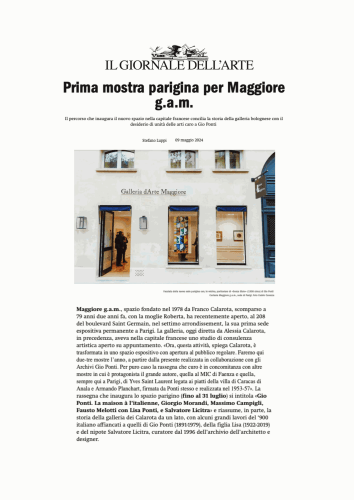Maggiore g.a.m., founded in 1978 by Franco Calarota, who passed away at the age of 79 two years ago, along with his wife Roberta, has recently opened its first permanent exhibition venue in Paris at 208 Boulevard Saint Germain in the seventh arrondissement. The gallery, now directed by Alessia Calarota, previously operated an art consultancy studio in Paris by appointment. "Now, this activity," explains Calarota, "has transformed into an exhibition space with regular public openings. We will host here two to three exhibitions each year, starting with the current one produced in collaboration with the Gio Ponti Archives. By pure chance, the exhibition I am curating coincides with other exhibitions featuring the great artist, including the one at the MIC in Faenza and another one here in Paris, dedicated to Yves Saint Laurent's plates from the villa in Caracas of Anala and Armando Planchart, signed by Ponti himself and created between 1953-57." The exhibition inaugurating the Parisian space (running until July 31) is titled "Gio Ponti. La maison à l'italienne, Giorgio Morandi, Massimo Campigli, Fausto Melotti with Lisa Ponti, and Salvatore Licitra" and partially summarizes the history of the Calarota gallery, featuring some major Italian works from the 20th century alongside those of Gio Ponti (1891-1979), his daughter Lisa (1922-2019), and his nephew Salvatore Licitra, who has been curator of the architect and designer's archive since 1996.
The curator, however, mentioned Villa Planchart because the idea for the Maggiore exhibition derives from the practical realization of what Ponti wrote in the first editorial for the magazine "Domus," dedicated to "La Casa all'Italiana." This was supposed to bring together architecture, manufacturing, craftsmanship, industry, and Italian art into a single project. Thus, along the Parisian path, one can admire the creations of compatriots desired by the designer within the Planchart art collection: some Morandi ("Morandi rejects the present. He paints without an epoch," said Gio Ponti about the Bolognese painter), a series of brass and ceramic sculptures, including the rare "Circles" from the 1960s and the bas-relief "Angel" from 1954 by Melotti, and the "Medallions" from 1962 by Campigli, along with paper executions by Ponti himself and his two relatives. At the end of the visit, therefore, the words expressed by the architect in his book "Amate l'architettura" ("Love Architecture") echo in the mind. Architecture is a crystal: "We talk about the unity of the arts: we want painting and sculpture to contribute to architecture in a 'unity of the arts' (unity understood as union: union understood as assumption). Is it difficult for this to happen in the generation of a work of art, except in cases of ideal friendship between architect and painter: thus, I conceived the atrium of the Faculty of Arts in Padua for the walls frescoed by Campigli (Campigli is one of the few who have the vocation to collaborate exactly with some architects: he is perfect). Did this collaboration occur in the past? It occurred only that architecture hosted painting."



